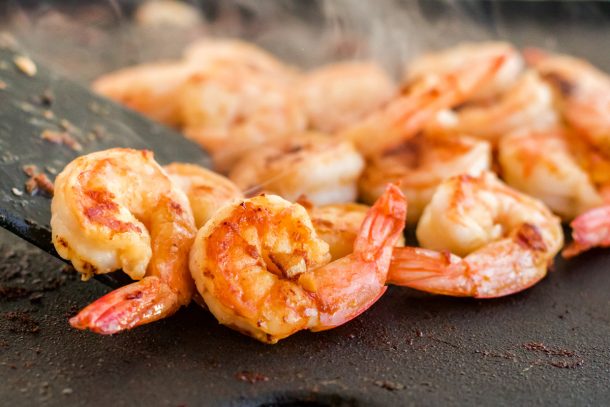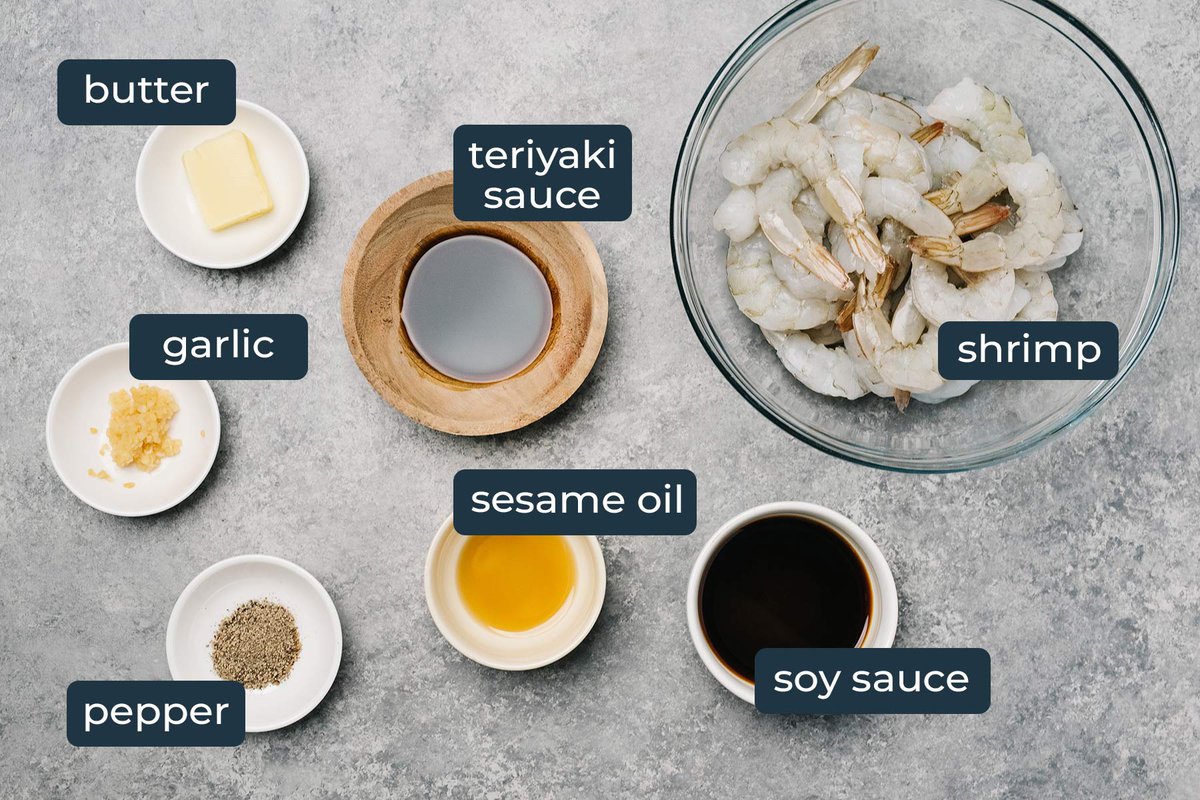Enjoy tasty hibachi shrimp at home with buttery shrimp cooked in a rich Asian-style sauce in just 5 minutes. Pair it with some hibachi rice, noodles, veggies and the addictive Yum Yum sauce.
Today we’ll be making some hibachi shrimp to wrap up the hibachi series. You can get the full hibachi experience at home if you missed out on the fun. We made hibachi steak and chicken and served them with hibachi rice, noodles, and vegetables.
You can choose this perfectly seared shrimp that is cooked in butter and garlic and then tossed in a soy-teriyaki sauce to go with your rice, noodles, and vegetables. They have that gorgeous sear and the signature taste you’ll find in most Japanese steakhouses. Dip it in some creamy yum yum sauce and you’re set. Let’s start searing!.
Hibachi shrimp is a favorite dish at Japanese steakhouses, where chefs theatrically cook the shrimp right at your table. The shrimp get an amazing char from the super hot grill, and they soak up the butter and garlic seasoning for incredible flavor. While eating hibachi is always fun, you don’t need to go out to enjoy this dish. With just a few simple ingredients, you can make restaurant-quality hibachi shrimp right in your own kitchen.
In this article we’ll walk through everything you need to know to cook hibachi shrimp at home. We’ll cover how to choose the right shrimp prep the shrimp properly, season it perfectly, get the right sear, and serve it like they do at your favorite restaurant. After reading this, you’ll be ready to impress your family with your own hibachi cooking skills.
Choosing the Right Shrimp
Obviously, you can’t make great hibachi shrimp without great shrimp Here are a few tips for selecting shrimp that will cook up perfectly on the grill
-
Go for raw shrimp. Hibachi chefs start with raw shrimp to get the full range of textures as the shrimp cooks. This allows the exterior to get seared while the inside cooks gently. Pre-cooked shrimp won’t give you the same effect.
-
Pick a larger size. Jumbo, extra-large or large shrimp work best for getting a nice sear without overcooking the insides. Medium shrimp cooks so quickly that it’s easier to overcook.
-
Buy shell-on shrimp. The shells help retain moisture and flavor as the shrimp cooks. Just be sure to remove the shell before eating.
-
Devein the shrimp. The dark vein along the back of the shrimp contains grit and can make the shrimp taste muddy. Removing it takes just a few minutes but makes a big difference.
-
Pat shrimp dry. Damp shrimp will steam instead of sear. Be sure to pat off any excess moisture with paper towels before cooking.
Prepping Shrimp for Grilling
Once you’ve got great shrimp, proper prep ensures you get picture-perfect results:
-
If necessary, use kitchen shears to cut along the back of the shell and gently pull it off. Leave the tail intact if desired.
-
Use a paring knife to make a shallow cut along the back of the shrimp to expose the vein. Pull out the vein with the tip of the knife.
-
Rinse the shrimp under cool running water and pat very dry with paper towels.
-
If desired, drizzle the shrimp with a tablespoon or two of olive oil and toss gently to coat. This helps promote even browning.
-
Sprinkle both sides with a pinch of salt to lightly season.
That’s all the prep you need. Now the shrimp are ready to meet the heat.
Creating the Perfect Hibachi Shrimp Seasoning
While the sear from the hot grill provides loads of flavor, a seasoning blend brushed on during cooking gives hibachi shrimp its signature taste. This easy homemade blend only requires a few ingredients:
Butter: A couple tablespoons of melted butter provide a rich, savory flavor as the shrimp cooks. Clarified butter or ghee are even better since they won’t burn as easily.
Garlic: For a classic hibachi shrimp flavor profile, you need garlic. Use 2-3 cloves minced or pressed.
Soy sauce: A couple tablespoons of soy sauce lend a savory, salty flavor and promote browning. Low-sodium soy sauce lets you control the salt level.
Rice wine vinegar or mirin: Just a splash of rice vinegar or mirin contributes sweetness to balance the soy.
Sesame oil: A few drops of sesame oil gives everything a lovely nutty flavor.
White pepper: This adds a hint of heat without overpowering the other flavors.
Simply combine the above ingredients right before cooking the shrimp. Brush the mixture over the shrimp as they cook for full flavor infusion. Easy!
Executing the Perfect Sear
Cooking hibachi-style shrimp over intense heat does two things:
-
It gives you an amazing charred exterior full of smoky, grill flavors
-
It cooks the interior gently so the shrimp stays tender and juicy
This takes a ripping hot cooking surface. The flat-top griddles used in restaurants reach over 500°F. While home cooks can’t quite match that, getting your pan or grill as hot as possible is key. Here are some tips:
-
Use a well-seasoned cast iron skillet or grill pan. These retain heat well at high temperatures.
-
Preheat your pan for at least 10 minutes over maximum heat until it just starts to smoke.
-
Use high-heat cooking oils like avocado, rice bran or grapeseed oil. Olive oil can burn.
-
Dry the shrimp again right before cooking. Any drips will cause flare-ups.
-
Don’t overcrowd the pan. Cook in batches if needed so shrimp sear rather than steam.
-
Don’t move the shrimp once they hit the pan. Let them sear undisturbed to get a good crust.
-
Cook for just 1-2 minutes per side depending on size. Shrimp overcooks quickly.
Follow these tips and your shrimp will get a perfect char while staying moist inside.
Brushing on the Sauce
The sauce for hibachi shrimp does triple duty. First, it provides tons of flavor as it cooks into the shrimp. Second, the soy sauce accelerates browning through its sugars and amino acids. Finally, it helps promote caramelization as it sticks to the hot cooking surface.
To get the most out of the sauce:
-
Brush shrimp with sauce right as they go onto the hot pan.
-
Cook shrimp for about 1 minute undisturbed to sear.
-
Flip shrimp and brush again with sauce.
-
Let cook 1 minute more until done.
Brush on just enough sauce to coat the outside of the shrimp. Too much will make them mushy and inhibit browning.
Serving Hibachi Shrimp
Hibachi restaurants serve shrimp with lots of side dishes and sauces. While not strictly necessary, these accompaniments make the meal complete. Here are some easy ways to serve your homemade hibachi shrimp:
-
On hibachi rice: A bed of buttery Japanese-style rice is the perfect foil for shrimp. Get our simple hibachi rice recipe here.
-
With stir-fried veggies: Quick-cooking veggies like zucchini, carrots and bean sprouts pair well with shrimp. Toss them in soy sauce and sesame oil as they cook.
-
With yum yum or eel sauce: These Japanese mayo-based sauces add creaminess and sweetness. Learn to make yum yum sauce here.
-
With grilled pineapple: Grilled fruit is an unexpected but amazing partner for shrimp. Brush pineapple slices with brown sugar as they grill.
-
On shrimp tempura: For a fun twist, dip cooked shrimp in tempura batter and briefly fry until crispy.
However you choose to serve them, properly cooked hibachi shrimp are sure to be a hit at your table. Now that you know how to prep, season and sear shrimp just right, you can bring the fun and flavors of the hibachi grill to your own kitchen.

Ingredients in Hibachi Shrimp

How To Make Hibachi Shrimp (1 Min Video)
While cooking hibachi, food like meat, vegetables, seafood, noodles, or rice are cooked on a flat top grill over very high heat. A fancy show with a hibachi chef at a Japanese steakhouse like Kobe or Benihana is usually part of these.
Hibachi shrimp are cooked over high heat in garlic, butter, and an Asian stir-fry sauce made with soy sauce, teriyaki, or mirin. Sesame oil is drizzled on top to finish.
To make this at home, you don’t need a flat surface like the fancy hibachi grill. A good wok or cast iron pan will work just as well to achieve the same level of sear. If you don’t own a wok or cast iron pan, you can get away with using a regular skillet but you won’t get the same level of sear.
Hibachi Shrimp At Home Better Than Benihana | Plus Colossal Shrimp! (Hibachi At Home)
How do you season hibachi shrimp?
Most Hibachi chefs use soy sauce, garlic, and sesame oil to season the shrimp. This can also be used to season the white rice while cooking. The delicious blend of butter garlic and more taste fabulous with shrimp and vegetables. Sometimes ginger is also added depending on what is being cooked in the hibachi recipe.
How do you cook hibachi shrimp?
Hibachi shrimp are seared over high heat in butter, garlic, an Asian stir-fry sauce made with soy sauce and teriyaki or mirin and finished with a drizzle of sesame oil. To make this at home, you don’t need a flat surface like the fancy hibachi grill. A good wok or cast iron pan will work just as well to achieve the same level of sear.
Can I use pre cooked shrimp for hibachi?
It is important that the shrimp is patted dry before being placed on the heat source to get that nice sear for the hibachi style. You can use pre-cooked shrimp if you like, but because we are using high heat for stir fry it is very easy to overcook and I find it easier to prevent rubbery texture by starting with raw shrimp.
What is hibachi shrimp?
Hibachi shrimp is an Asian-inspired dish that consists of shrimp cooked in a soy sauce and garlic sauce. This recipe is a perfect copycat of the hibachi shrimp dish that’s served at Benihana! What seasonings do they use for hibachi? The seasonings for hibachi shrimp consist of pantry staples that you likely already have at home.
